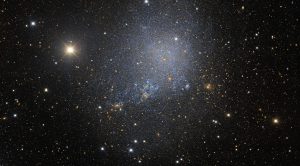This irregular dwarf galaxy, named IC 1613, contains some 100 million stars (bluish in this portrayal). It is a member of our Local Group of galaxy neighbors, a collection which also includes our Milky Way, the Andromeda spiral and the Magellanic clouds. 2.4 million light-years away, it contains several examples of Cepheid variable stars — key calibrators of the cosmic distance ladder. The bulk of its stars were formed about 7 billion years ago, and it does not appear to be undergoing star formation at the present day, unlike other very active dwarf irregulars such as the Large and Small Magellanic clouds. To the lower right of IC 1613 (oriented with North to the left and East down in this view), one may view a background galaxy cluster (several hundred times more distant than IC 1613) consisting of dozens of orange-yellow blobs, centered on a pair of giant cluster elliptical galaxies. To the left of the irregular galaxy is a bright, sixth magnitude, foreground Milky Way star in the constellation of Cetus the Whale, identified here as a star by its sharp diffraction spikes radiating at 45 degree angles. For coordinate information, visit the NOIRLab webpage for this photo. Photo: DES/NOIRLab/NSF/AURA. Acknowledgments: Image processing: DES, Jen Miller (Gemini Observatory/NSF’s NOIRLab), Travis Rector (University of Alaska Anchorage), Mahdi Zamani & Davide de Martin

